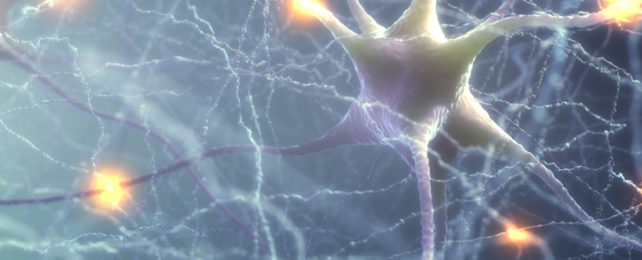 Illustration of a neuron sending a signal along its axon. (KTSDESIGN/Science Photo Library/Getty Images)
Illustration of a neuron sending a signal along its axon. (KTSDESIGN/Science Photo Library/Getty Images)Despite the decades of time and billions of dollars being invested in studying Alzheimer's disease, aspects of its development remain stubbornly mysterious. Researchers have chased down many leads, from gum disease to autoimmune disorders.
Now, using a mouse model of Alzheimer's disease, a team from Yale University in the US may have figured out why the patches of protein seem relevant without necessarily being directly responsible.
"We found that hundreds of axons develop [swelling] around each amyloid deposit," Yale University neurobiologist Peng Yuan and colleagues write in their paper.
They found the swelling is formed by a buildup of lysosomes – little bin-bag-like compartments created by cells to break down waste and contain it until it can be removed. These lysosomes clump into spheroid structures along the axons of brain cells – the long 'transmission cable' that extends from the cell's body, and ends in branches of signal-sending extensions.
Using calcium and voltage imaging of individual cells, the team were able to show the amount of signal disruption was linked to the spheroid sizes. The spheroid swellings remain stable for long periods of time, so likely continue to disrupt neuron connectivity.
The size and numbers of the spheroids seen in a small number of post-mortem human brain samples that Yuan and colleagues were able to analyze also correlated with levels of cognitive decline. In other words, those with more severe Alzheimer's disease had more swollen spheroids.
"Given the similarity in the morphology, organelle and biochemical content of [spheroids] in mice and humans, it is probable that, in humans, these are also stable structures that could disrupt neural circuits for extended intervals," the researchers explain.
The team found that high levels of PLD3 occasionally led to lysosome enlargement even in healthy mice. However, it was more pronounced in the spheroids located near the amyloid plaques in the mice with Alzheimer's, suggesting something about the plaques exacerbates the swelling process.
These final links need further investigation to confirm.
"It may be possible to eliminate this breakdown of the electrical signals in axons by targeting PLD3 or other molecules that regulate lysosomes, independent of the presence of plaques," explains Yale University neuroscientist Jaime Grutzendler.
As we've seen before with Alzheimer's, things may prove to still be more complicated, yet again.
"We have identified a potential signature of Alzheimer's which has functional repercussions on brain circuitry, with each spheroid having the potential to disrupt activity in hundreds of neuronal axons and thousands of interconnected neurons," summarizes Grutzendler.
This research was published in Nature.
